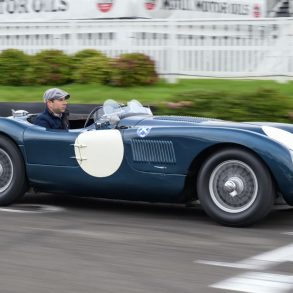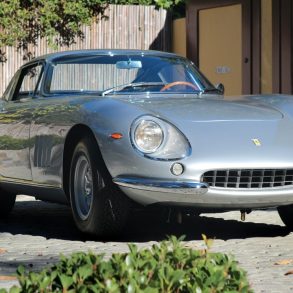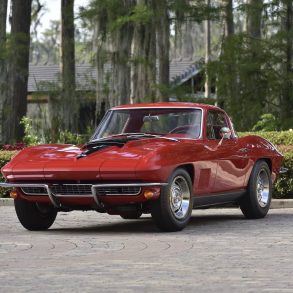The unique and celebrated prototype Jaguar ‘E2A’ as driven by no fewer than four of the world’s greatest racing drivers is to be offered for the first time at auction, headlining Bonhams & Butterfields’ annual Quail Lodge sale, in California, on August 15th, 2008. It is expected to fetch in excess of $7-million.
Presented in wonderfully original and unspoiled ex-works condition, this unique and immensely important British sports-racing legend has been lovingly preserved in just one family ownership for over 40 years and – extraordinarily – it is in effect a one-owner car ex-works.
By 1960 Jaguar had won the world’s most prestigious motor race, the Le Mans 24-Hours, no fewer than five times; twice with its original competition-tailored C-Type and three times with the tail-finned D-Type.
Jaguar had withdrawn from fully-focused works team competition after 1956, but had continued to maintain a racing presence through such customer teams as Briggs Cunningham’s in America, and Ecurie Ecosse in the UK.
Now company head Sir William Lyons had decreed that it was time for the marque’s phenomenal sporting pedigree to benefit production with an all-new semi-monocoque chassised design which was to emerge in 1961 as the Jaguar E-Type. One prototype for this model – the ‘missing link’ between D-Type and E-Type – emerged as ‘E2A’, a powerful fuel-injected 3-litre sports-racing two seater which was to be raced by famous American sportsman Briggs Cunningham’s experienced team at Le Mans in 1960.
The new ‘E2A’ was to test several features of the forthcoming E-Type production model, not least its independent rear suspension system in place of the live-axle featured in both the C-Type and D-Type designs. Visually the new car’s tail-finned rear bodywork recalled the charismatic D-Type, while its handsomely proportioned one-piece forward bodywork presaged the lovely lines of the forthcoming E-Type.
The Jaguar experimental department at Brown’s Lane, Coventry, completed the car in February 1960, powered by an aluminum-block fuel-injected 3-litre 6-cylinder engine. It was subsequently finished for the Cunningham team in their famous American racing colours, white overall with two parallel centerline stripes in dark blue.
In the 1960 Le Mans 24-Hours, that June, Cunningham entrusted this unique beauty to the incredibly strong driver pairing of the contemporary BRM Formula 1 team’s ex-Ferrari star Dan Gurney and veteran multiple SCCA Champion Walt Hansgen. They ran the car successfully well into the night-section of the long race, but fuel injection pipe failures created a weak mixture which caused burned pistons and a blown cylinder head gasket. The car was forced into retirement after completing 89 laps of the historic Sarthe circuit. In the April Test weekend at Le Mans, Walt Hansgen had set 2nd fastest lap time overall in ‘E2A’ – averaging some 125mph and splitting the Ferrari factory team’s latest model 3-litre V12-engined 250 Testa Rossa Indipendente sports-racing cars. Indeed, one of E2A’s great strengths was its straight-line speed. Aerodynamicist Malcolm Sayer was quoted as saying E2A was geared to achieve 200 mph at 7,000 rpm and later told Roger Woodley that she managed 6,800 rpm on the Mulsanne Straight – an incredible 194.29mph.
Then loaned to the Cunningham team for the rest of the season, and in fact labeled the ‘Cunningham E-Type’, ‘E2A’ was taken to the US where Briggs Cunningham’s engineering director Alfred Momo was free to fit a full 3.8-litre XK 6-cylinder engine – with triple Weber twin-choke carburetors, developing a recorded 294bhp at 5,500rpm – for SCCA racing.
The team then presented the car for its American racing debut on August 27, 1960, at Bridgehampton, Long Island, NY, where it was to be driven by Walt Hansgen. In his hands, ‘E2A’ promptly led throughout and won handsomely, beating not only a Lister-Jaguar but also a lightweight, disc-braked ‘Birdcage’ Maserati into 2nd and 3rd places.
Two weeks later, the car was then driven by Hansgen in the important Road America 500-Miles race at Elkhart Lake, Wisconsin, finishing comfortably in 3rd place overall and demonstrating not only his own skill in late-race wet weather driving but also the new all-independently-suspended Jaguar’s capabilities in such conditions.
October 1960 then saw the Cunningham Team enter the car for America’s biggest professional road race, the ‘Los Angeles Times‘ Grand Prix at Riverside, California. There it was entrusted to Formula 1’s new double-World Champion Driver, the Cooper team leader, Jack Brabham. Running against much lighter-weight free-Formula sports car competition, the great Australian star finished 10th.
Finally, for the Pacific Grand Prix at Laguna Seca, California, second of the great Fall Series of American West Coast professional road races, ‘E2A’ was run for Jack Brabham’s Formula 1 Cooper team-mate Bruce McLaren, before being sidelined by pre-race problems.
This important prototype car then returned to the factory where its distinctive tail fin was removed and the car repainted green to act as a press ‘decoy’ during testing of Jaguar’s rear-engined XJ-13 V12 sports-prototype. It was also used by the Dunlop company to test their frontier-technology Maxaret anti-lock braking system, and a legacy of this – a firing button for their onboard chalk-marker measurement device – has survived on the dash panel.
Ultimately, in the late 1960s, Jaguar engineer Roger Woodley was successful in negotiating purchase of ‘E2A’ for his father-in-law, the prominent collector and racing photographer Guy Griffiths. It has remained in the family ever since – having been exhibited for many years in their Cotswold Museum at Chipping Campden – and Guy’s equally enthusiastic daughter, Penny Griffiths-Woodley (now Penny Graham) has kept it in highly original condition, running it on such special occasions as the Goodwood Festival of Speed, the 1996 Jaguar cavalcade from Browns Lane to Le Mans, and in the Jaguar E-Type 40th anniversary tribute at the Goodwood Revival Meeting.
While ‘E2A’ as offered by Bonhams & Butterfields is fitted currently with a 3.8-litre XK competition engine, an original competition 3-litre power unit is offered with the car.
Describing ‘E2A’ in his definitive book ‘Jaguar – Sports Racing & Works Competition Cars from 1954′ the revered marque historian Andrew Whyte declared: “As one-off engineering exercises of the kind at which Jaguar excelled, ‘E2A’ is a classic. The build quality achieved by Bob Blake and his colleagues was exceptional – indeed throughout the factory in the ’50s and ’60s, there were special skills ready and willing to do special one-off jobs of that kind.”
James Knight, International Head of Bonhams’ motoring department said:
“Jaguar ‘E2A’ is absolutely one of the most charismatic and significant prototypes ever produced by the mainstream motor industry, at any time, anywhere. As the taproot of the magnificent E-Type Jaguar series, ‘E2A’ would be enormously significant for that alone. But when you consider its Le Mans 24-Hours racing history, its association with four such all-time great racing drivers as Sir Jack Brabham, Bruce McLaren, Dan Gurney and Walt Hansgen – not to mention its win at Bridgehampton and strong third place at Road America – it offers pretty much all the finest attributes any connoisseur could ever seek in a road-useable sports-racing classic; all this, and good looks too.”
[Source: Bonhams & Butterfields]










